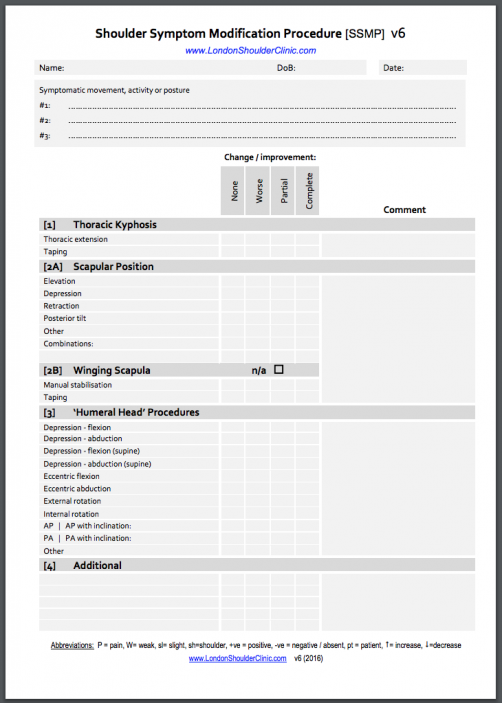Shoulder Symptom Modification Procedure
Original Editor - Naomi O'Reilly
Top Contributors - Rachael Lowe, Naomi O'Reilly, Kim Jackson, George Prudden, Simisola Ajeyalemi, Rucha Gadgil, Tony Lowe and Robin Tacchetti
Introduction[edit | edit source]
The Shouldr Symptom Modification Tool (SSMP) is an approach to aassessents with rotator cuff and subacromial pathology described by Jeremy Lewis in 2009[1]. SSMP is a set of four mechanical techniques used in a sequence while the patient performs a movement that reproduces their symptoms. The aim is to identify one or more methods that reduce their symptoms and/or increasing movement and function[2]. This tool offers a method to objectively assess the shoulder with the focus being to identify movements and techniques that might be contributing factors to the symptomatic movement and not to label the pathology or exact cause of pain and then utilise these movements and techniques as a means to guide treatment.
Procedure[edit | edit source]
The SSMP techniques involve:
- Techniques to reduce the thoracic kyphosis
- Scapular positioning techniques
- Humeral head positioning procedures
- Pain and symptom neuromodulation procedures
Evidence[edit | edit source]
- Lewis, J. S. (2009) Rotator cuff tendinopathy/subacromial impingement syndrome: is it time for a new method of assessment? British Journal of Sports Medicine, Vol 43, pp. 259-264
- Lewis JS. Rotator cuff tendinopathy: a model for the continuum of pathology and related management. Br J Sports Med. 2010 Oct;44(13):918-23. http://bjsm.bmj.com/content/44/13/918
- Lewis JS, Tennent TD. How effective are diagnostic tests for the assessment of rotator cuff disease of the shoulder? In: MacAuley D, Best TM, editors. Evidenced Based Sports Medicine. 2nd ed. London: Blackwell Publishing; 2007.
Resources[edit | edit source]
References[edit | edit source]
- ↑ Lewis, J. S. (2009) Rotator cuff tendinopathy/subacromial impingement syndrome: is it time for a new method of assessment? British Journal of Sports Medicine, Vol 43, pp. 259-264
- ↑ Eleanor Richardson & Jeremy Lewis, The Shoulder Symptom Modification Procedure (SSMP) , https://www.shoulderdoc.co.uk/article/1478







